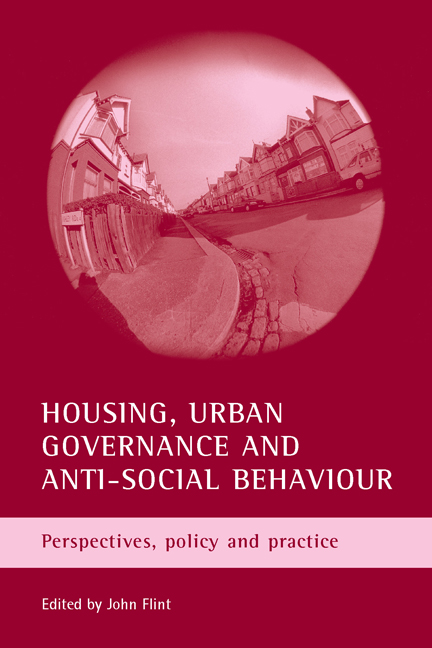Book contents
- Frontmatter
- Contents
- List of tables, figures and photographs
- Acknowledgements
- Notes on contributors
- Introduction
- Part 1 The definition and construction of anti-social behaviour in the UK
- Part 2 Legal techniques and measures utilised by social landlords to address anti-social behaviour
- Part 3 The emerging mechanisms of addressing anti-social behaviour in housing governance
- Part 4 Studies of housing and anti-social behaviour from an international perspective
- Index
three - Labelling: constructing definitions of anti-social behaviour?
Published online by Cambridge University Press: 15 January 2022
- Frontmatter
- Contents
- List of tables, figures and photographs
- Acknowledgements
- Notes on contributors
- Introduction
- Part 1 The definition and construction of anti-social behaviour in the UK
- Part 2 Legal techniques and measures utilised by social landlords to address anti-social behaviour
- Part 3 The emerging mechanisms of addressing anti-social behaviour in housing governance
- Part 4 Studies of housing and anti-social behaviour from an international perspective
- Index
Summary
Introduction
In this chapter we consider the epistemic underpinnings of anti-social behaviour (ASB). We identify its struggle to become simultaneously technical and vernacular as well as provide the conditions for a certain convergence in the roles of experts, legislators, interpreters and mediators (Osborne, 2004). We suggest that ASB is not just a concept but also a ‘vehicular idea’, rather like the ‘third way’, through which a diverse set of ideas about crime and society become melded together, and are driven on by both rationality and critique. Ultimately, such ideas may be ‘utterly shallow and venal’, but the essence of a vehicular idea is its ability to be ‘open to the emergence of “radical” variants within it’ (McLennan, 2004, p 497). The potency of ASB as a vehicular idea is its ability to be manipulated by different types of intellectual or expert. Like the third way, it has little in its core that is new but incorporates a multiplicity of diverse, low- and high-level deviant behaviours with a set of unconnected ideas about risk, crime and management underpinning it. It also has some powerful mediators who ‘get things moving’ (Osborne, 2004, p 440). Nevertheless, ASB also ‘marks out a space in which people can argue, a space of diagnosis’ (Osborne, 2004, p 440).
Although the concept of ASB may be utterly shallow, the space in which it exists is also one in which the circles of control have become much closer. This is, we suspect, partly because of the ragbag of ideologies, understandings and concepts that have invested power on the term, ASB. In particular, the space of ASB has been shaped by understandings about risk which, in turn, have related ASB to housing tenure, specifically social housing. That location of ASB has also been shaped, we suggest, by two further factors. Firstly, social housing is fundamentally managed housing and thus provides the conditions through which the control of the marginal becomes possible. Secondly and related to this point, ASB taps into a series of ethical values about poverty and pauperisation which have existed in this tenure since the heyday of private philanthropy and the development of the charitable instinct in housing, as described in Chapter One (this volume).
- Type
- Chapter
- Information
- Housing, Urban Governance and Anti-Social BehaviourPerspectives, Policy and Practice, pp. 57 - 78Publisher: Bristol University PressPrint publication year: 2006
- 1
- Cited by



